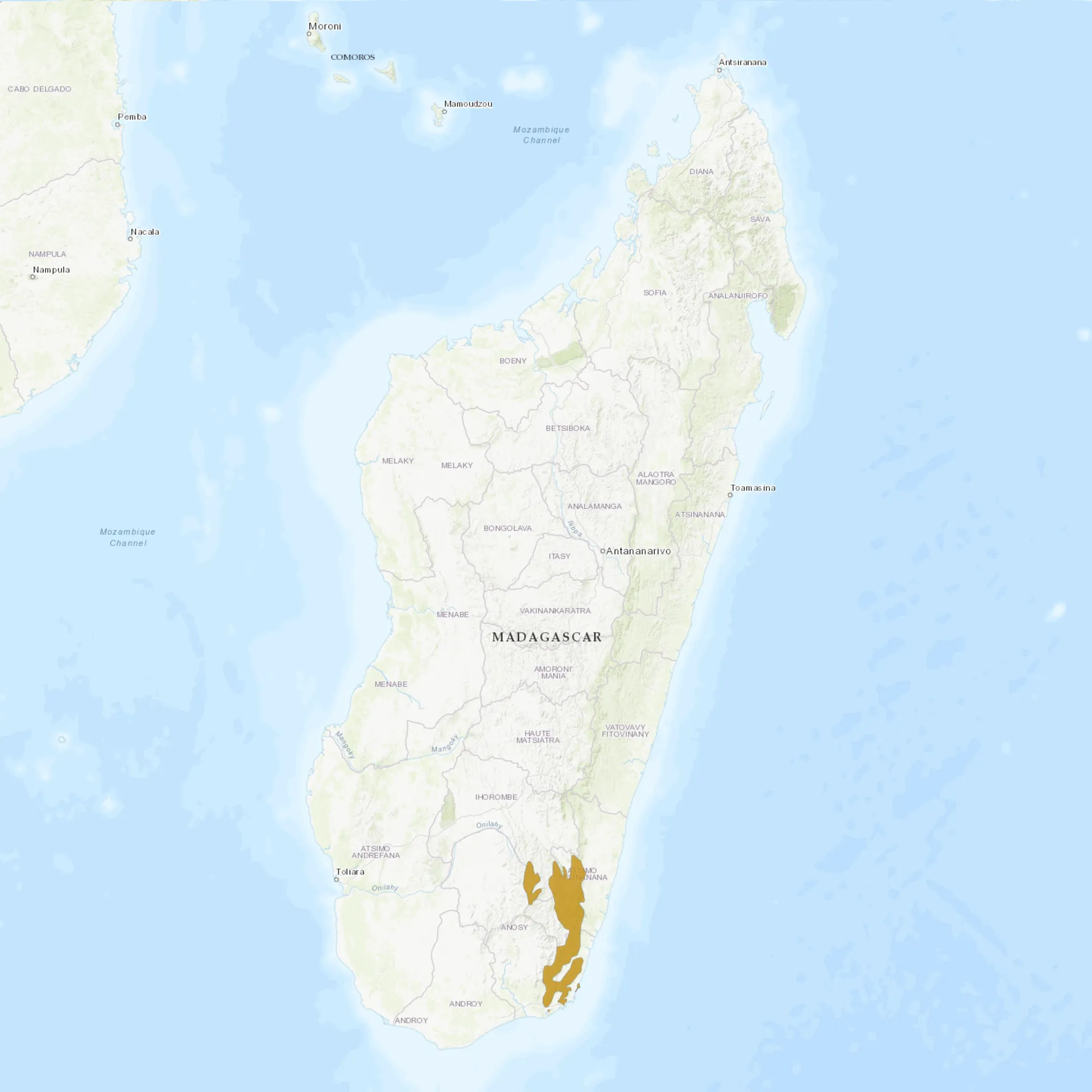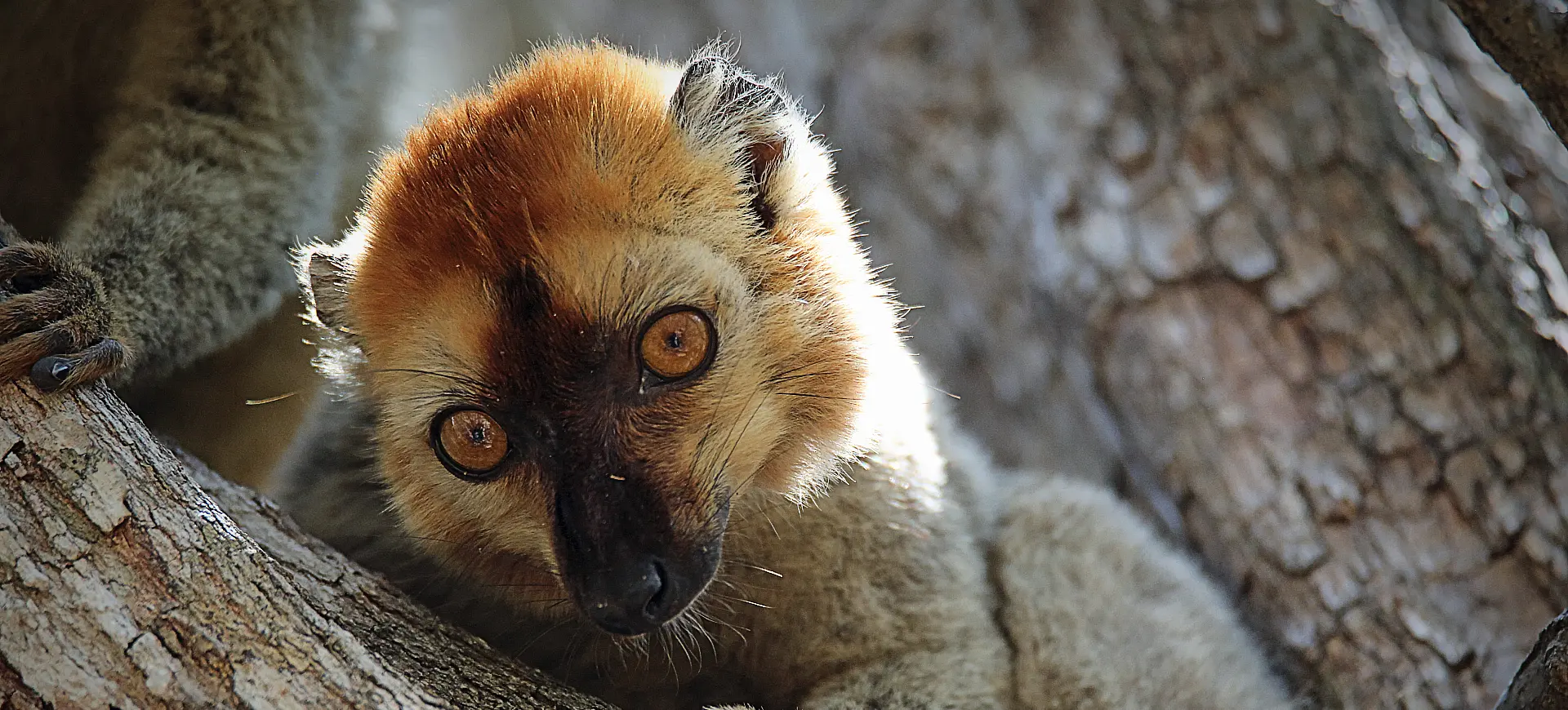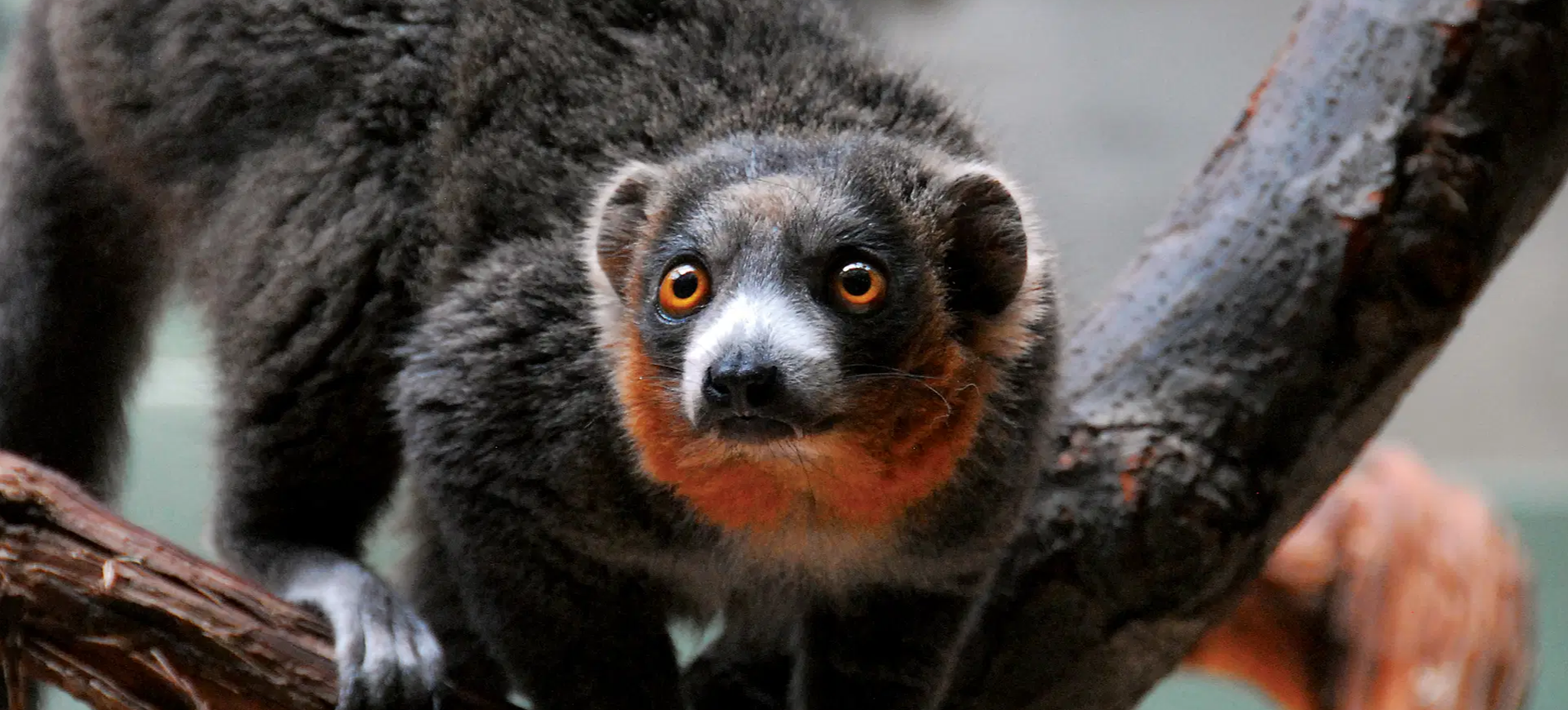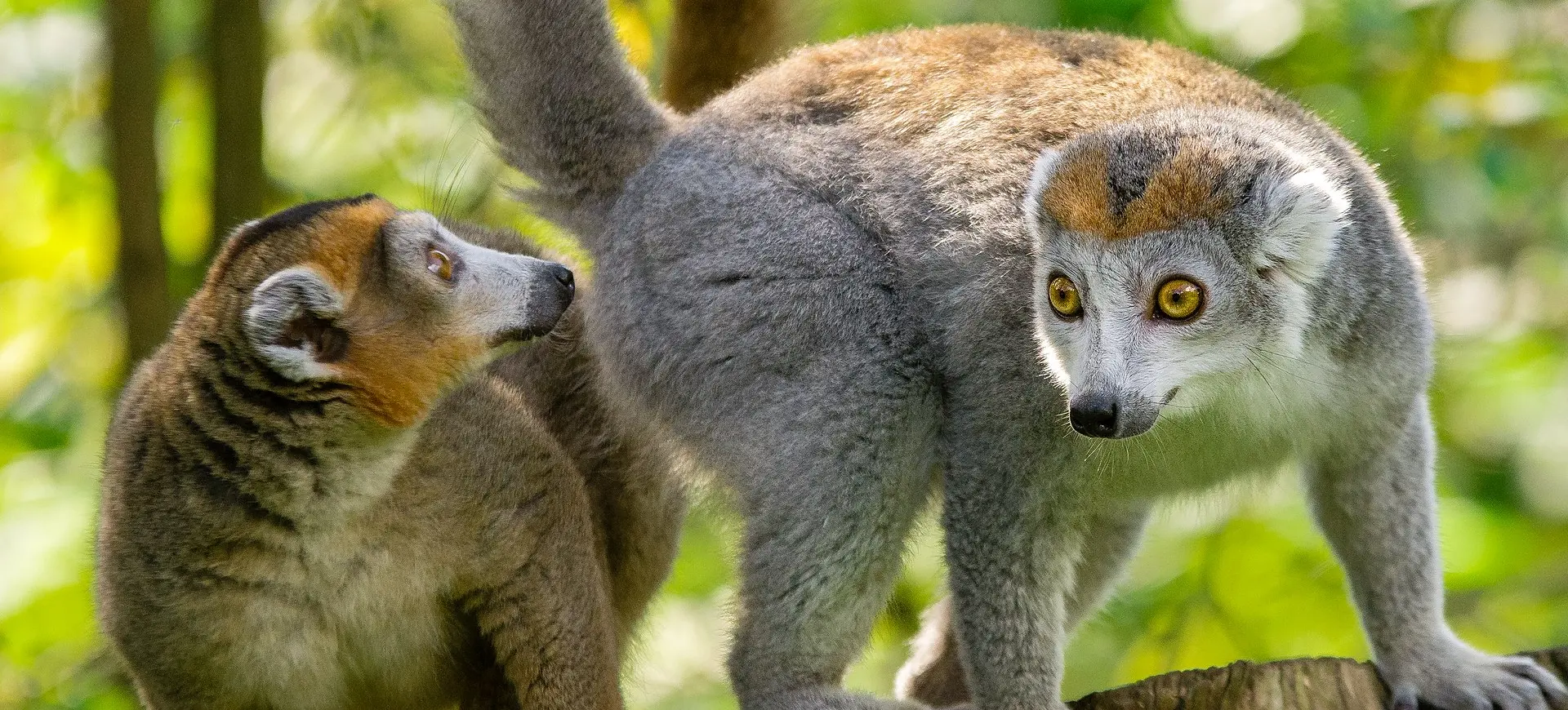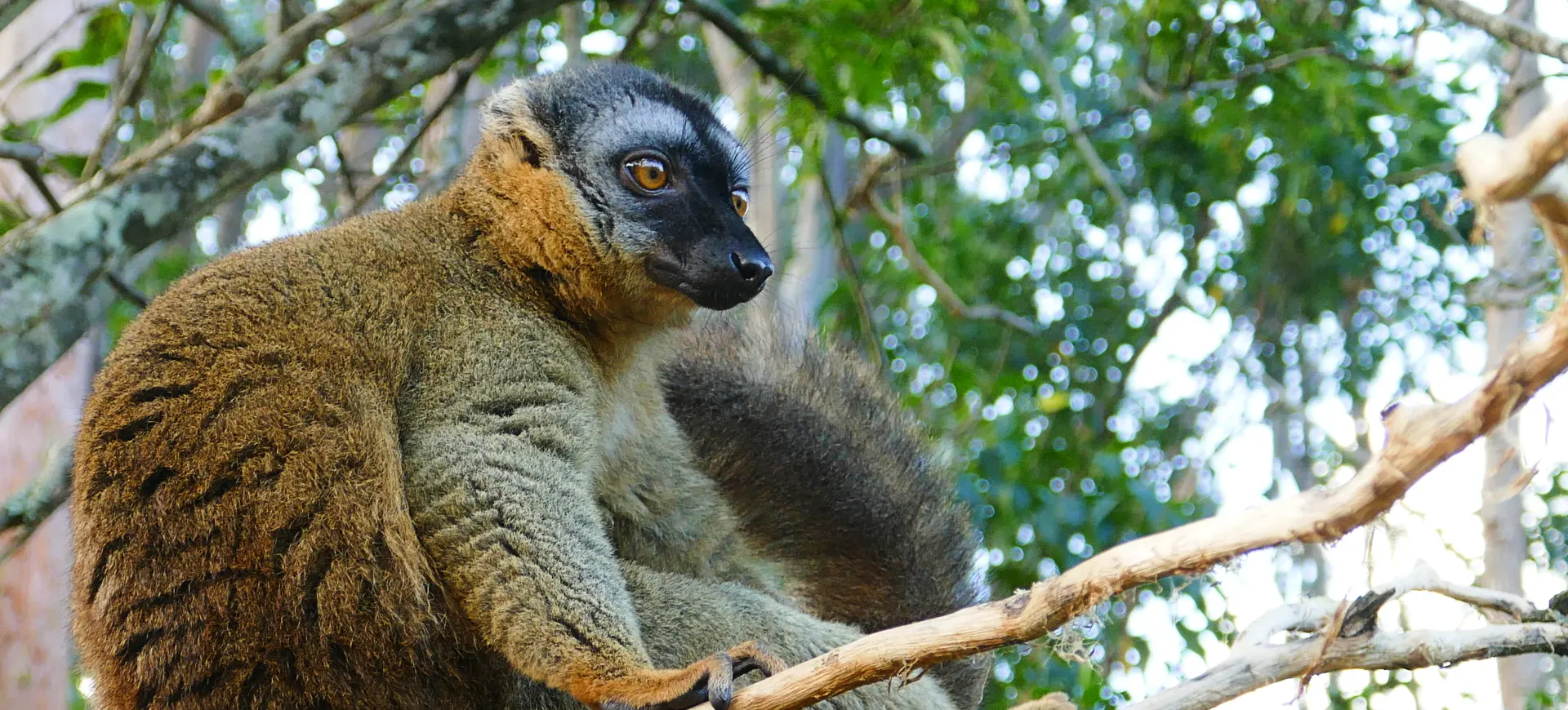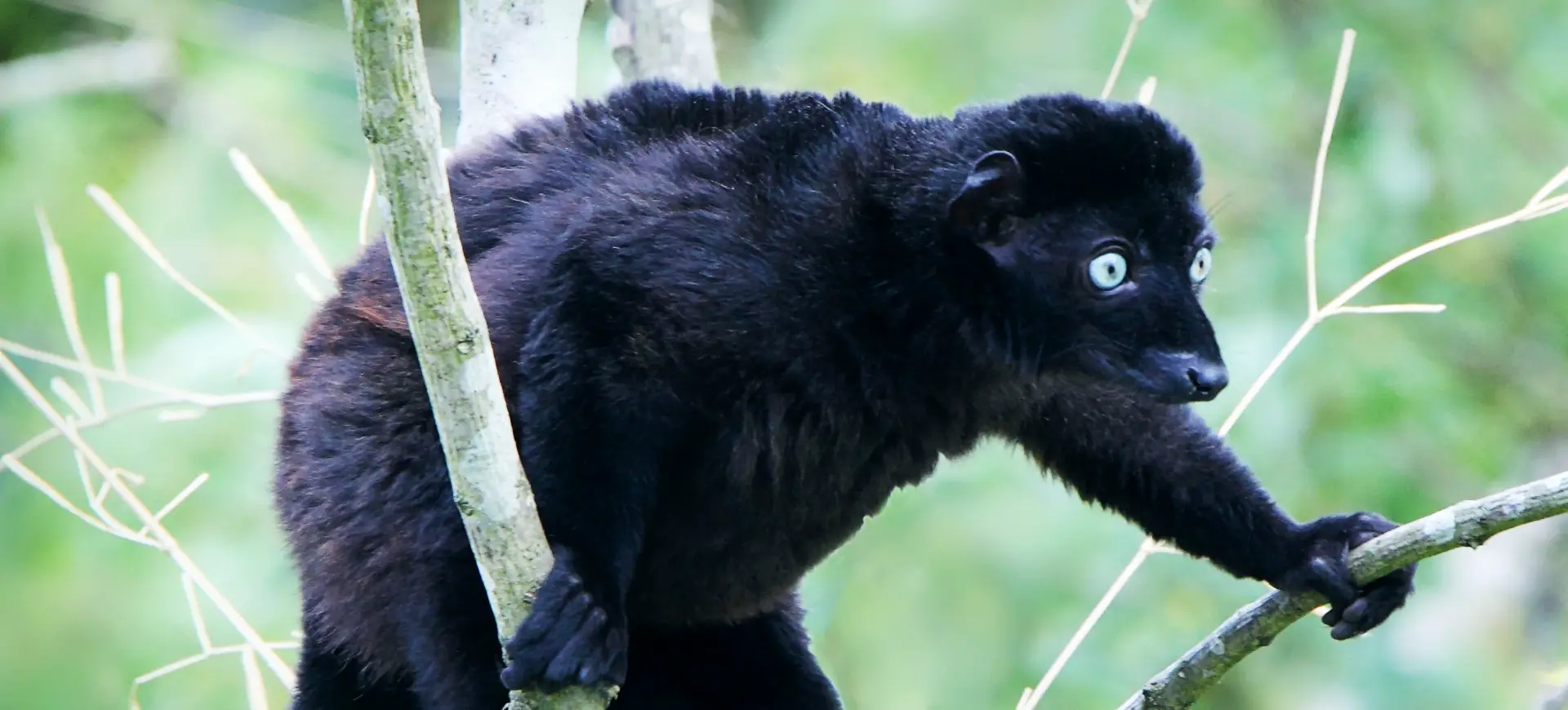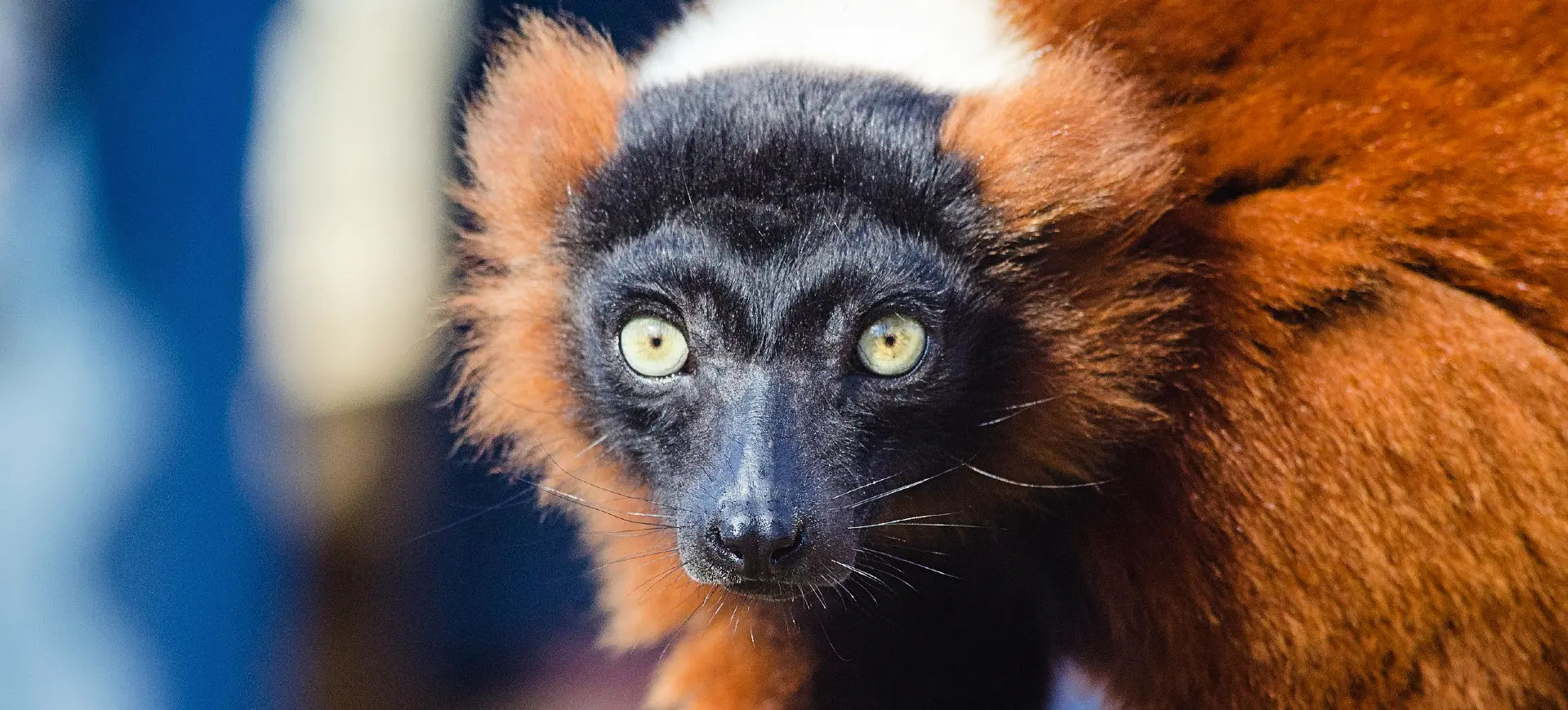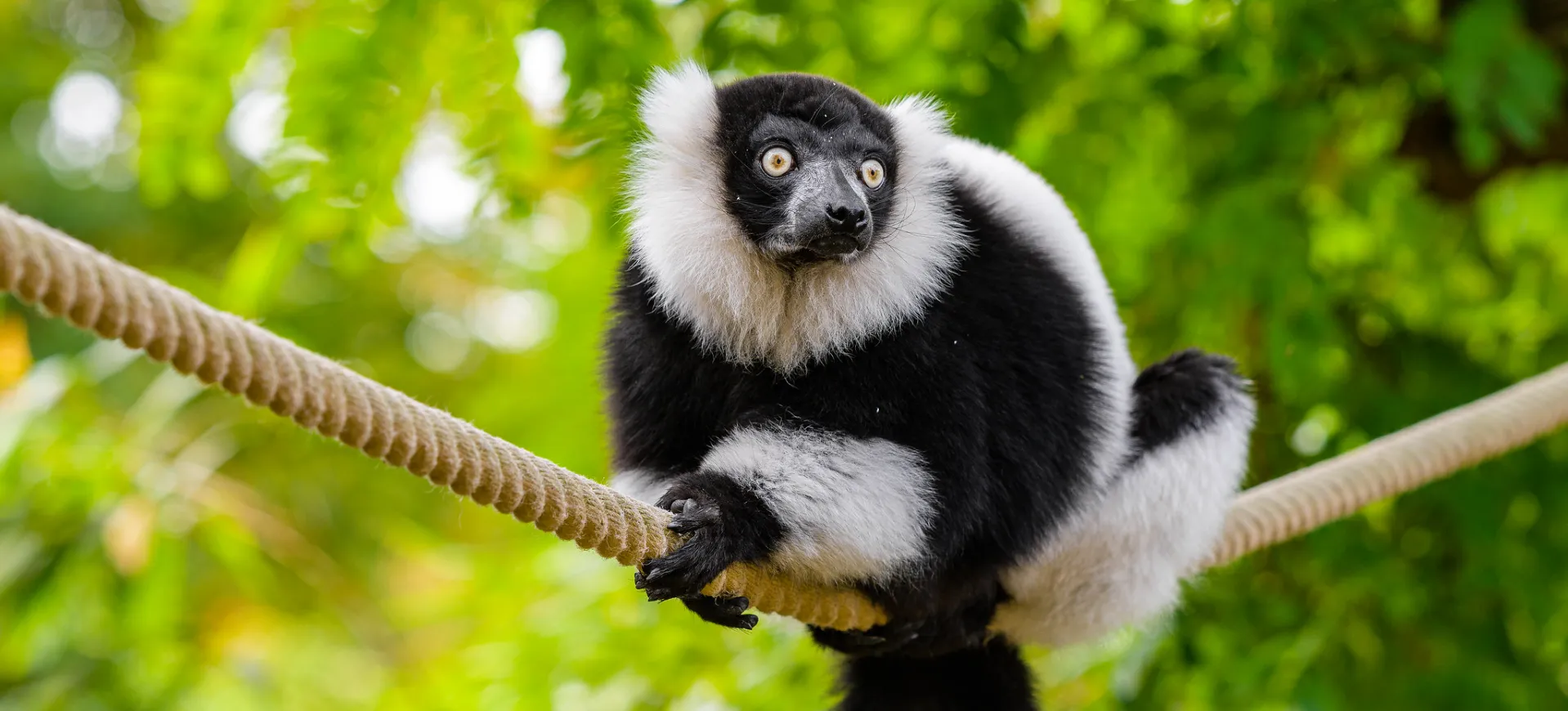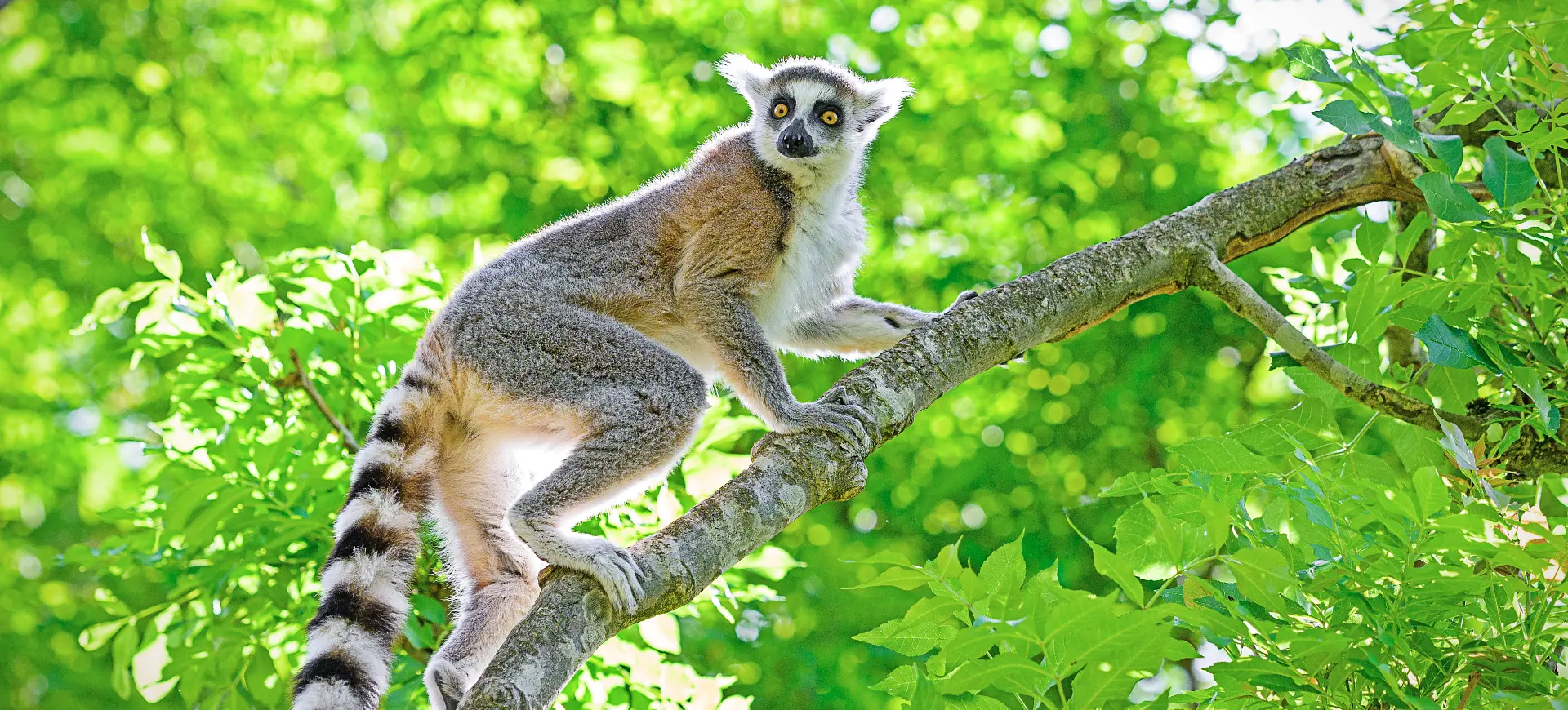Overview
The Collared Brown Lemur is a medium-sized primate endemic to the southeastern rainforests of Madagascar, known for its distinctive facial markings and social behavior. It is sexually dichromatic, with males and females exhibiting different facial coloration—males have a dark gray or black face with white cheek patches. In contrast, females display a lighter face with more uniform coloration. The species is arboreal and primarily active during the day (diurnal), although some populations may show crepuscular activity. It inhabits lowland and mid-altitude humid forests, often foraging in the upper canopy.
Collared Brown Lemurs are highly social and live in multi-male, multi-female groups, typically ranging from 2 to 12 individuals. Their vocal communication includes grunts, clicks, and alarm calls, which are used to maintain group cohesion and warn of predators. These lemurs are frugivorous but consume leaves, flowers, and other plant materials depending on seasonal availability. They serve as important seed dispersers in their native ecosystems, contributing to forest regeneration.
The species faces significant threats from habitat loss due to slash-and-burn agriculture, illegal logging, and charcoal production. Hunting for bushmeat also poses a serious threat in some areas, particularly outside protected zones. Despite these pressures, Collared Brown Lemurs persist in several protected areas, although fragmented habitat limits their long-term viability. Conservation measures, including habitat protection and community-based forest management, are essential for their survival.
Current distribution:
The Collared Brown Lemur is endemic to southeastern Madagascar, with a range limited to humid forests between the Manampatrana River in the north and the Mananara River in the south. It is found in several protected areas, including Andohahela National Park and Manombo Special Reserve, but much of its range lies outside conservation zones. The species’ distribution is patchy due to extensive deforestation and fragmentation, which isolate populations and reduce genetic diversity. Forest corridors between protected areas are rapidly disappearing, exacerbating the effects of habitat fragmentation.
Depending on forest quality, food availability, and human activity, local populations vary in density. In degraded habitats, group sizes tend to be smaller, and reproductive success may be reduced. Surveys suggest that populations are declining throughout their range due to persistent anthropogenic pressures. Conservation-focused research and habitat mapping are ongoing to better understand its distribution and support targeted protection measures.
Physical Description:
The Collared Brown Lemur has a dense, soft coat that varies in color from grayish-brown to reddish-brown, depending on sex and individual variation. Males are typically darker with a black or dark gray face contrasted by white cheek patches, while females are lighter with gray or buff-colored facial features. Both sexes have a distinct “collar” of fur around the neck area, giving the species its common name. The long, bushy tail is not prehensile but is used for balance during arboreal locomotion.
These lemurs have forward-facing eyes that provide good binocular vision for navigating dense forest canopies. Their hands and feet are adapted for grasping branches, with opposable thumbs and a grooming claw on the second toe. Adults display a relatively long body and tail compared to other lemur species, supporting their agile movements in the trees. Juveniles resemble adult females in coloration and develop full adult pelage within their first year.

Lifespan: Wild: ~20 Years || Captivity: ~35 Years

Weight: Male: 4.8–5.9 lbs (2.2–2.7 kg) || Female: 4.2–5.5 lbs (1.9–2.5 kg)

Length: Male: 34–39 in (86–99 cm, including tail) || Female: 32–38 in (81–97 cm, including tail)

Top Speed: 12 mph (19 km/h)
Characteristic:
Native Habitat:
The Collared Brown Lemur is native to Madagascar’s southeastern humid forests, primarily in the regions between the Manampatrana and Mananara rivers. It inhabits lowland and mid-elevation evergreen forests, often at elevations ranging from sea level to approximately 1,200 meters. The species prefers continuous, dense forest cover and relies on tall canopy structures for foraging and social interaction. It is rarely found in highly disturbed habitats but can persist in selectively logged forests.
These lemurs are strictly arboreal and spend most of their time in the mid to upper canopy, using quadrupedal locomotion and leaping to navigate the forest. Resting sites are often located in dense foliage or vine tangles, providing concealment and protection. Forest edges, especially near rivers or marshes, are occasionally used for foraging when fruit is scarce. High rainfall, warm temperatures, and year-round plant productivity characterize their habitat.
Climate Zones:
Biomes:
WWF Biomes:
Biogeographical Realms:
Continents:
Countries:
Diet:
Diet & Feeding Habits:
The Collared Brown Lemur is primarily frugivorous, consuming a wide variety of fruits throughout the year, particularly during the wet season when fruit is abundant. In periods of fruit scarcity, it supplements its diet with leaves, flowers, bark, and occasionally invertebrates. It feeds at various heights in the forest canopy, often traveling considerable distances to access seasonal food sources. Feeding is a social activity, with groups often sharing fruiting trees and coordinating movement.
Its dietary flexibility helps it cope with the seasonal changes typical of Madagascar’s forests, although fragmentation can limit food availability. This lemur plays a critical role in seed dispersal due to its frugivorous habits, often consuming fruits whole and excreting viable seeds. It has been observed to favor certain plant species, including fig trees and other fruiting species of ecological significance. Water is primarily obtained through moisture in food or from dew and rainwater collected on leaves.
Mating Behavior:
Mating Description:
Collared Brown Lemurs exhibit seasonal breeding, with mating typically occurring during the austral winter (May to July). The species practices polygynous mating, with dominant males gaining more frequent access to receptive females. Courtship behaviors include scent-marking, vocalizations, and physical displays such as tail-raising and chasing. Copulation is brief, and dominant individuals may guard mates to prevent rival access.
Gestation lasts approximately 120 days, with births occurring between September and November, coinciding with the onset of the rainy season. Most females give birth to a single offspring yearly, though twins can occasionally occur. Infants cling to the mother’s belly during the first few weeks before transitioning to riding on her back. Maternal care is strong; group members may also engage in communal grooming and infant guarding.
Reproduction Season:
Birth Type:
Pregnancy Duration:
Female Name:
Male Name:
Baby Name:
Social Structure Description:
Collared Brown Lemurs live in cohesive social groups of multiple adult males and females and their offspring. Group sizes generally range from 5 to 12 individuals, with flexible dominance hierarchies and no strict matriarchal structure as seen in some other lemur species. Social interactions include grooming, play, and vocal communication, which help maintain group cohesion. Upon reaching maturity, males may temporarily leave their natal groups to join or form other groups.
Cooperative behaviors such as shared vigilance and infant care are common, especially among related females. Group members rely on vocal and olfactory signals to coordinate movement and alert others to threats. Intergroup encounters are typically avoided, but can involve vocal displays and posturing when they occur. Seasonal shifts in food availability may lead to temporary changes in group ranging patterns or fission-fusion dynamics.
Groups:
Conservation Status:
Population Trend:
The Collared Brown Lemur population is declining due to rapid habitat loss and fragmentation, which limit reproductive success and restrict gene flow. Most wild populations are small and isolated, making them vulnerable to inbreeding and local extinction. In areas with moderate protection, populations can persist, but their long-term viability is uncertain without broader landscape connectivity. Ongoing monitoring indicates that some subpopulations may already be extinct or extirpated from portions of their historical range.
Captive populations are limited and genetically narrow, maintained primarily in European and Malagasy institutions participating in breeding programs. These programs aim to preserve genetic diversity and raise awareness of the species’ plight. Captive breeding success has been moderate, but reintroduction is not feasible due to continued threats in the wild. Genetic studies are underway to assess viability and support in situ and ex-situ conservation planning.
Population Threats:
The primary threat to the Collared Brown Lemur is habitat destruction driven by slash-and-burn agriculture, logging, and charcoal production. Madagascar’s forests have undergone extensive degradation, particularly in the southeast where this species resides. Human encroachment into protected areas continues to increase, reducing the effective range available for lemur populations. In some areas, remaining habitat patches are too small to support viable groups.
Hunting for bushmeat is another significant threat, especially in regions with low enforcement or during economic hardship. Lemurs are also occasionally captured for the illegal pet trade, although this is less common than subsistence hunting. Fragmentation isolates populations, limits dispersal, and increases vulnerability to disease and natural disasters. Climate change may further alter forest composition and flowering cycles, impacting food availability.
Conservation Efforts:
Conservation efforts for the Collared Brown Lemur include habitat protection through Madagascar’s national park and reserve system. Andohahela and Manombo are key conservation sites with some level of habitat management and community engagement. International conservation organizations are working with local communities to implement sustainable land-use practices and promote reforestation. Environmental education programs target awareness in nearby villages to reduce hunting and forest exploitation.
Captive breeding programs are managed under regional studbooks and involve coordination among zoos and research centers. Genetic research and population viability analyses guide breeding strategies to maximize genetic health. Ongoing field surveys and ecological studies aim to refine conservation priorities and identify critical habitat corridors. Collaboration between government agencies, NGOs, and local stakeholders is crucial to long-term success.
Additional Resources:
Fun Facts
- The name “lemur” comes from the Latin word ‘lemures,’ which means ‘ghosts or spirits’. This refers to their nocturnal habits and eerie, reflective eyes.
- The Collared Brown Lemur can consume certain toxic millipedes. They stimulate the millipede to release its toxins and then rub it over their fur to act as an insect repellent.
- These lemurs are known to ‘sunbathe’, sitting upright facing the sun with their arms and legs splayed out to soak up the warmth.
- Unlike most primates, lemurs have a ‘wet nose’ similar to a dog’s, enhancing their sense of smell.
- In lemur social groups, females are often dominant over males, which is unusual in the primate world.
- Lemurs are one of the most vocal primates and use a variety of calls to communicate with their troop.
- Despite their small size, lemurs are capable of making jumps of over 20 feet (6 meters) in the forest canopy.
- Lemurs are believed to have arrived in Madagascar by “rafting” over the ocean on clumps of vegetation and trees millions of years ago.
- Collared Brown Lemurs have a long gestation period compared to other mammals of their size, with pregnancies lasting around 120 days.
- The Collared Brown Lemur, like many lemur species, plays a crucial role in its ecosystem as a seed disperser.


